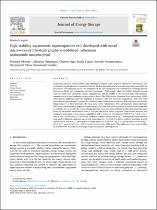| dc.contributor.author | Ekwere, Precious | |
| dc.contributor.author | Ndipingwi, Miranda | |
| dc.contributor.author | Ikpo, Chinwe | |
| dc.contributor.author | Yussuf, Sodiq | |
| dc.contributor.author | Nwambaekwe, Kelechi | |
| dc.contributor.author | Uhuo, Onyinyechi | |
| dc.contributor.author | Iwuoha, Emmanuel | |
| dc.date.accessioned | 2023-04-12T08:19:06Z | |
| dc.date.available | 2023-04-12T08:19:06Z | |
| dc.date.issued | 2023-02-06 | |
| dc.identifier.citation | Ekwere, Ndipingwi, M., Ikpo, C., Yussuf, S., Nwambaekwe, K., Uhuo, O., & Iwuoha, E. (2023). High stability asymmetric supercapacitor cell developed with novel microwave-synthesized graphene-stabilized ruthenium antimonide nanomaterial. Journal of Energy Storage, 63. https://doi.org/10.1016/j.est.2023.106853 | en_US |
| dc.identifier.uri | http://hdl.handle.net/10566/8757 | |
| dc.description.abstract | Ruthenium antimony oxide (RuSbO), and ruthenium antimony oxide graphene (RuSbO-G) nanomaterial was
synthesized via the microwave-assisted method for the first time and tested as a possible electrode material for an
asymmetric supercapacitor device. The formation of the nanocomposites was confirmed by scanning electron
microscopy (SEM) and transmission electron microscopy (TEM) images where the RuSbO material showed
randomly distributed spherically shaped nanoparticles, and the RuSbO-G showed ruthenium and antimony
nanoparticles scattered randomly on the graphene sheets. The SEM-electron dispersion X-ray spectroscopy (SEMEDS)
showed significant proof for nanoparticle formation with the elemental composition, while the X-ray
photoelectron spectroscopy confirmed the oxidation states of the elements present. Both materials were further
characterized in a three-electrode cell setup using cyclic voltammetry (CV), galvanostatic charge-discharge
(GCD) and electrochemical impedance spectroscopy (EIS) and their electrochemical properties were compared
to establish their suitability for energy storage purposes. From the result, different double layer properties were
shown by the RuSbO and RuSbO-G in the 1 M Li2SO4 electrolyte. When compared to the RuSbO electrode, the
composite had greater energy storage capabilities with a maximum capacitance of 289.47 F g 1 at 0.1 A g 1
current load. An efficiency of ~100 % was reached at a current density of 0.5 A g 1. Subsequently, both materials
were used to fabricate a portable asymmetric supercapacitor. The RuSbO-G device yielded a maximum specific
capacitance of 167.96 F g 1, resulting in an energy density of 75.58.0 W h kg 1 at a power density of 360 W kg 1
at 0.1 A g 1 current load, with ~100 % charge retention after 4900 cycles. This study turns a new research light
on RuSbO based materials as an energy storage material for supercapacitors. | en_US |
| dc.language.iso | en | en_US |
| dc.publisher | Elsevier | en_US |
| dc.subject | Antimony | en_US |
| dc.subject | Energy storage | en_US |
| dc.subject | Microwave synthesis | en_US |
| dc.subject | Nanomaterials | en_US |
| dc.subject | Pseudocapacitance | en_US |
| dc.subject | Ruthenium | en_US |
| dc.subject | Supercapacitors | en_US |
| dc.title | High stability asymmetric supercapacitor cell developed with novel microwave-synthesized graphene-stabilized ruthenium antimonide nanomaterial | en_US |
| dc.type | Article | en_US |

